Soil Health and Conservation Planning
Regional Conservation Partnership Program
The Long Island Sound Watershed Regional Conservation Partnership Program (LISW-RCPP) is a landscape-scale initiative that covers the geographic area of Long Island Sound (the Sound) and its watershed. Funded by the U.S. Department of Agriculture’s Natural Resources Conservation Service (NRCS), the LISW-RCPP supports efforts that find common ground among agricultural producers and conservation organizations in working towards the sustainable use of soil, water, and other natural resources.
Our approach is to provide a team (with expertise in agronomy, engineering, pasture management, cover cropping, manure management, livestock and vegetable production, soil health, farming in a changing climate, food safety, weed management, farm energy use, and farm viability) to work with individual farmers in the watershed. By working with individual farmers to address their specific goals and challenges, we are seeking to build soil health and restore and protect water quality.
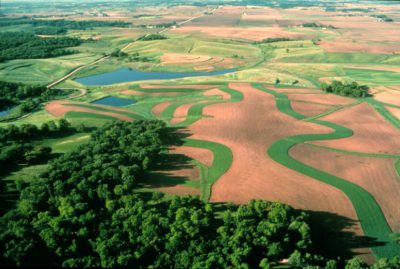
What’s critical about soil health now?
1. World population is projected to increase from 7.7 billion in 2019 to more than 9 billion in 2050. To sustain this level of growth, food production will need to rise by 70 percent.
2. Between 1985 and 2010, 22% of prime farmland in Connecticut were lost to development.
3. Healthy soil is the foundation for profitable, productive, and environmentally sound agricultural systems.
Technical Assistance
Conservation District partners will provide technical assistance to navigate the Environmental Quality Incentives Program (EQIP) eligible agricultural producers, especially those not previously reached by USDA NRCS programs. This will include the development of conservation plans leading to the completion of nutrient management plans on farms throughout the watershed over the life of the program.
Work can include soil, plant and manure sampling and testing as needed, as well as monitoring and documentation of conservation practices implemented as a result of conservation planning activities. In collaboration with technical assistance provided by the University of Connecticut Cooperative Extension Service, conservation planning project will lead to implementation management strategies that promote nutrient cycling and retention.
Conservation Planning
A Conservation Plan is a tool designed to help you better manage the natural resources on your farm. With your help, a soil conservationist will inventory the resource conditions existing on your farm. They will help you interpret the information about your land, its soil, and production capability. You can discuss resource concerns and solutions, field by field. The Revised Universal Soil Loss Equation estimates the amount of soil erosion caused by water. Five factors are used to figure soil loss: rainfall, soil erodibility, slope length and steepness, crop type and management, and erosion control practices. Different conservation options will be presented to reduce the amount of erosion. A conservation plan includes aerial photos of your fields, soil maps and descriptions, a list of locations and information sheets explaining specific management decisions, and a plan for operation and maintenance of practices, if needed. Some examples of conservation strategies are further explained below.
Nutrient Loading in the Long Island Sound

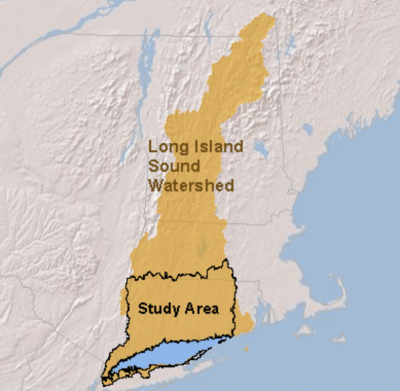
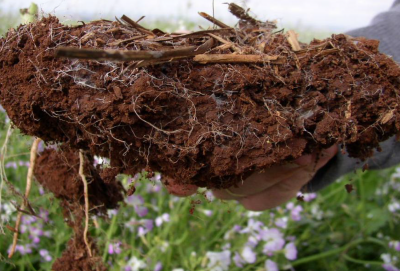
The Role of SOM in the Nitrogen Cycle
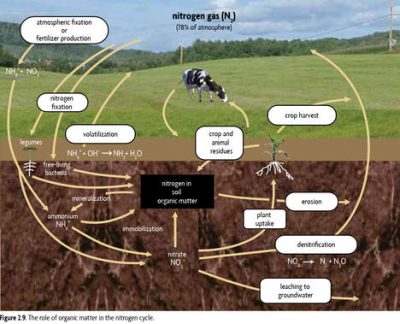
Soil organic matter (SOM) is the key to building and maintaining healthy soils because it has such great positive influences on all soil properties. Soil organic matter is a storehouse of several plant nutrients, including nitrogen, phosphorus, and sulfur. Every 1 percentage point of organic matter in the top 6 inches of soil contains about 1,000 pounds of nitrogen, 230 pounds of phosphorus, and 165 pounds of sulfur per acre. However, most nutrients in organic matter are not directly available to plants. To be used by plants, nutrients in organic matter must be converted to inorganic forms through decomposition and mineralization by soil organisms. SOM acts like a sponge to hold 90% of its weight in water. Soil with 2% organic matter can hold 32,000 gallons of water. (For context: about 27,000 gallons of water fall on one acre during a 1" rainstorm.) When soil can not absorb water, that water, along with excess nutrients like nitrogen and phosphorous, leave the farm as run-off.
Timing In Diversified Systems

Timing In Diversified Systems

Cover crops provide multiple potential benefits to soil health, while also helping maintain cleaner surface and groundwater. They prevent erosion, improve soil physical and biological properties, supply nutrients to the following crop, suppress weeds, improve soil water availability, and break pest cycles. Difference types of cover crops are able to break into compacted soil layers, increase nutrient retention, and or reduce soil erosion by covering the ground with living vegetation and living roots that hold on to the soil.
The Role of SOM in the Nitrogen Cycle
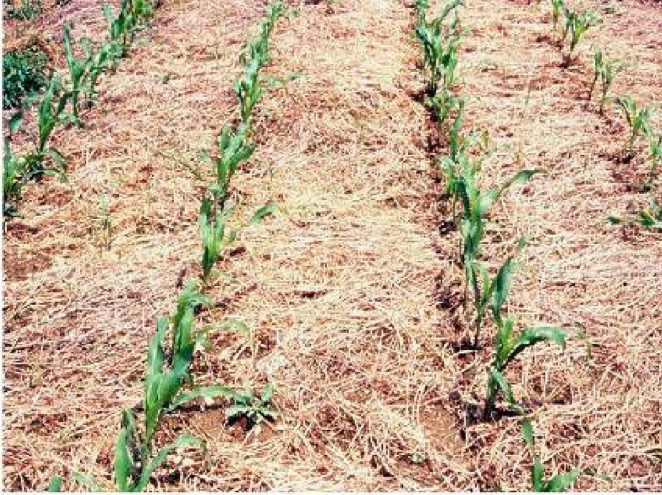
Reduced tillage systems are based on the idea that tillage can be limited to the area around the plant and does not have to disturb the entire field. Several tillage systems, no-till, zone or strip-till, and ridge-till fit this concept. Tillage systems are often classified by the amount of surface residue left on the soil surface. Conservation tillage systems leave more than 30% of the soil surface covered with crop residue. This amount of surface residue cover is considered to be at a level where erosion is significantly reduced. Reduced tillage systems also see more benefits of soil organic matter and conserve moisture.
Nitrogen and phosphorus behave very differently in soils, but many of the management strategies are actually the same or very similar. Both are needed by plants in large amounts, and both can cause environmental water quality harm when present in excess. Good nutrient management practices take into account the large amount of plant-available nutrients that come from the soil, especially soil organic matter and any additional organic sources like manure, compost, or a rotation or cover crop. When implemented, nutrient management strategies enhance uptake, reduce environmental losses, and lower farm inputs.
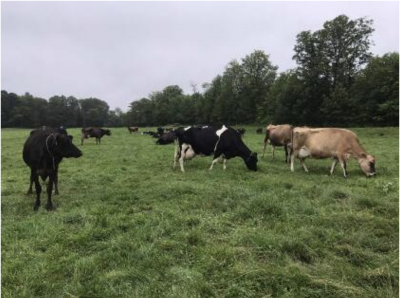
Prescribed Grazing is an approach that is especially effective at improving water quality. A diversity of plants and animals reduce nutrient export from cropland and hay land fields, recycling the majority of nutrients, minerals, vitamins, and carbon providing a higher livestock nutritional diet. Removal of herbage by the grazing animals is in accordance with production limitations, plant sensitivities and management goals. Frequency of defoliation and season of grazing is based on the rate of growth and physiological condition of the plants. Duration and intensity of grazing is based on desired plant health and expected productivity of the forage species to meet management objectives. When implemented prescribed grazing improves water infiltration, vegetative growth, protects stream banks from erosion, manages for deposition of fecal material way from water bodies, and promotes ecological and economically stable plant communities.
The Role of SOM in the Nitrogen Cycle

Conservation buffers are small areas or strips of land in permanent vegetation, designed to intercept pollutants and manage other environmental concerns. Conservation buffers slow water runoff, trap sediment, and enhance infiltration within the buffer. Buffers include: riparian buffers, filter strips, grassed waterways, shelterbelts, windbreaks, living snow fences, contour grass strips, cross-wind trap strips, shallow water areas for wildlife, field borders, alley cropping, herbaceous wind barriers, and vegetative barriers. Buffers also trap fertilizers, pesticides, pathogens, and heavy metals, and they help trap snow and cut down on blowing soil in areas with strong winds. In addition, they protect livestock and wildlife from harsh weather and buildings from wind damage.
Rotating crops usually means fewer problems with insects, parasitic nematodes, weeds, and diseases caused by plant pathogens. Rotations are an important part of any sustainable agricultural system, particularly for improving SOM. Yields of crops grown in rotations are typically 10% higher than those of crops grown in monoculture in normal growing seasons, and as much as 25% higher in drier growing seasons. Another important benefit of rotations is that growing a variety of crops in a given year spreads out labor needs and reduces risk caused by unexpected climate or market conditions. Other benefits may occur when perennial forages are included in the rotation, including decreased soil erosion and nutrient loss.
Integrated pest management, or IPM, is a sustainable approach that emphasizes ecosystem-based strategies that result in economical and long-term solutions to pest problems. The objective for IPM practitioners is to minimize risks to human health and the environment from the pest management actions implemented. IPM promotes the use and integration of multiple tactics such as biological control, use of resistant varieties, behavioral modification, and mechanical and cultural controls for pest management. A special emphasis is placed on prevention of the pest problem and on control by natural enemies of the pest organism. Chemical pesticides play a role only when this and other preventive steps failed.
Why does Soil Health matter?
1. Healthy soils sustain agricultural productivity.
2. Healthy soils reduce production costs.
3. Healthy soils promote nutrient cycling.
4. Healthy soils reduce nutrient leaching and sediment loss.
5. Healthy soils support biological pest controls.
6. Healthy soils better regulate water and air supply.
Testing
Soil tests are an important first step at assessing current soil resource conditions in order to adopt management strategies that promote nutrient retention and cycling within fields saving the producer time and money. The University of Connecticut Extension is working to support Connecticut farmers with a limited number of free soil tests at UConn’s Soil Nutrient Analysis Laboratory in exchange for partnering with our conservation practice research. It’s that easy!
Principles of Soil Health
Soil Health consists of five principles which are:
1. Keep it covered.
2. Minimize soil disturbance.
3. Maximize plant diversity.
4. Keep plants growing throughout the year to feed and protect the soil.
5. Livestock integration to promote nutrient cycling.
What is a Conservation Plan?
1. A Conservation Plan outlines a system of agricultural practices that enhance crop production, while improving water quality, air quality, energy efficiency and wildlife habitat. Some recommended Conservation Practices include: Diversified Rotation, Cover Crops, Reduced Tillage, Mulching, Nutrient Management, Prescribed Grazing, and Integrated Pest Management.
2. It saves energy by using less intensive tillage.
3. It saves water and increases drought tolerance by improving a soils water holding capacity and infiltration rate.
4. It reduces disease and pest problems.
5. It improves sustainability for farms and ranches.
6. It provides Environmental, Economic, and Social benefits.